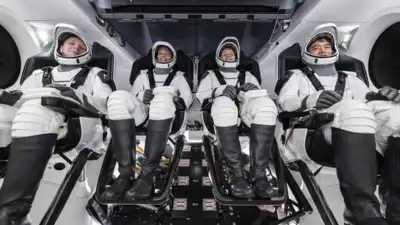In a pivotal moment for international space collaboration, a SpaceX Crew Dragon capsule successfully docked with the International Space Station (ISS) early Sunday, delivering four astronauts from the United States, Japan, and Russia. This mission facilitates the long-awaited return of NASA astronauts Barry “Butch” Wilmore and Sunita “Suni” Williams, who have been unexpectedly stationed aboard the ISS for over nine months due to technical issues with their original return vehicle. (Photo credit NASA)

Mission Overview
The SpaceX Crew-10 mission launched from NASA’s Kennedy Space Center in Florida at 7:03 p.m. ET on Friday. After approximately 29 hours in transit, the Crew Dragon capsule autonomously docked with the ISS at 12:04 a.m. ET on Sunday. The newly arrived crew comprises NASA astronauts Anne McClain and Nichole Ayers, Japanese Aerospace Exploration Agency (JAXA) astronaut Takuya Onishi, and Russian cosmonaut Kirill Peskov. They are slated for a six-month tenure aboard the space station, engaging in various scientific experiments and maintenance tasks.
Extended Stay of Wilmore and Williams
Wilmore and Williams embarked on their mission in June 2024 aboard Boeing’s inaugural crewed flight, anticipating a brief week-long stay. However, technical malfunctions with the Boeing Starliner capsule necessitated its uncrewed return to Earth, inadvertently extending their mission to over nine months. Throughout this period, both astronauts have continued to contribute significantly to the ISS’s operations, conducting scientific research and performing routine maintenance.
Transition and Training
The arrival of Crew-10 initiates a critical transition phase aboard the ISS. Over the next few days, Wilmore and Williams will orient the new crew members, ensuring a seamless handover of responsibilities. This overlap is essential for maintaining the continuity of ongoing experiments and station upkeep. The new astronauts will familiarize themselves with the station’s systems, emergency protocols, and daily operations under the guidance of their experienced predecessors.
Scheduled Return to Earth
Weather permitting, Wilmore and Williams are scheduled to depart the ISS on Wednesday, accompanied by NASA astronaut Nick Hague and Russian cosmonaut Aleksandr Gorbunov. They will return aboard the SpaceX Crew Dragon capsule that has been docked at the station since September, which had arrived with two empty seats specifically for this purpose. The capsule is expected to undock around 4 a.m. ET, followed by a re-entry and splashdown off the coast of Florida.
Political Implications and Accelerated Timelines
The delay in Wilmore and Williams’s return garnered political attention, with President Donald Trump and advisor Elon Musk, CEO of SpaceX, advocating for an expedited Crew-10 launch. They alleged, without substantiation, that the previous administration had neglected the astronauts’ situation for political reasons. This intervention underscores the intricate interplay between space exploration and political dynamics, highlighting the importance of timely crew rotations and the challenges posed by technical setbacks.
Astronauts’ Reflections
Despite the unforeseen extension of their mission, both Wilmore and Williams have remained resilient and focused on their duties. Williams expressed eagerness to reunite with her family and pets, acknowledging the emotional toll on her loved ones during her prolonged absence. She noted, “It’s been a roller coaster for them, … .” Their return will not only be a relief to their families but also a testament to the dedication and adaptability required in human space exploration.
Looking Ahead
The successful docking of Crew-10 and the anticipated safe return of Wilmore and Williams mark significant milestones in the ongoing efforts to maintain and utilize the ISS as a hub for international scientific research. These events also highlight the critical role of commercial partnerships in advancing space exploration and ensuring the safety and efficiency of crewed missions. As the new crew settles in, they will continue the legacy of their predecessors, contributing to the vast array of experiments and technological developments that the ISS facilitates.
In conclusion, the recent developments aboard the ISS underscore the collaborative spirit and resilience inherent in space exploration. The seamless transition between crews, despite unforeseen challenges, exemplifies the commitment of space agencies and their partners to advancing human knowledge and presence in space.
For more updated online news visit https://newsnestify.com/


